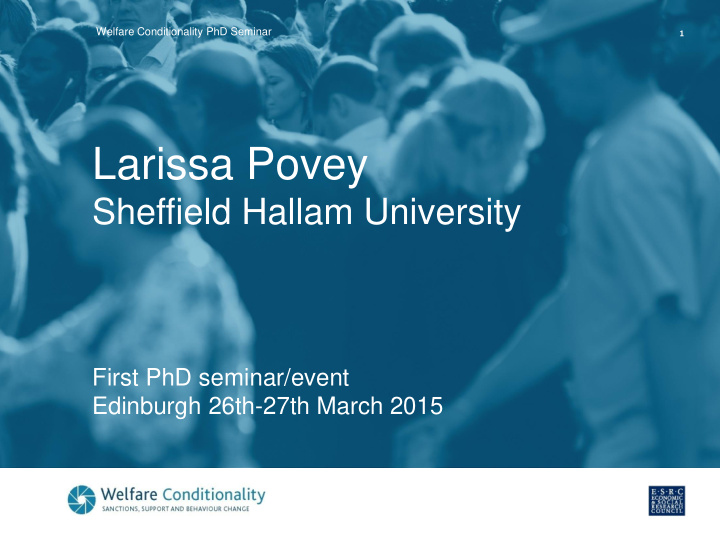



Welfare Conditionality PhD Seminar 1 Larissa Povey Sheffield Hallam University First PhD seminar/event Edinburgh 26th-27th March 2015
Conditional welfare and the gendered criminalisation of poverty
Overview • Background • Research rationale • Aims and objectives of the research • Facts and figures • Social profile of women offenders • Brief outline of relevant literature • Methodology • Next steps • Questions
Background • Previously worked for providers of Flexible New Deal, Work Programme and Offender Learning and Skills Service providers. • This PhD project will explore the impact of the new conditionality and sanctions regime on women who have offended or who are considered to be 'at risk' of offending. • Welfare and criminal justice as policy areas have undergone significant reform, particularly under the Coalition, which have a gendered impact.
Research rationale Welfare policy • Retrenching social provision with disproportionate impact on vulnerable groups eg, lone parents • Expanded conditionality, tougher sanctions = rising sanctions and hardship applications/awards Criminal justice policy • Drift from focus on women offenders under Coalition to reducing re- offending through extended monitoring and contracted out of probation of lower risk offenders • MOJ Transforming Rehabilitation • More empirical evidence on the effects of diversionary programmes required particularly in a changing landscape. • Ex-offenders spend half of their first 12 months after release in receipt of welfare benefits • Ex-offenders “day one" referral to Work Programme
Aims and objectives of the research Aim To re-examine Wacquant’s “ carceral-assistential net” employing a feminist lens, focusing on the lived realities of criminalized and ‘at risk’ women (Wacquant, 2009, p. 99). Main research question: • What is the impact of recent welfare and criminal justice policy reform on women at the social margins? Subsidiary questions: • How are women conceptualised as being 'at risk' or criminal in dominant narratives; what effect does this have on public opinion, policy and practice? • What are the lived realities of women categorised as such? • How does the interaction between a softer, pre-emptive (gender- differentiated) penal system and a more punitive (gender neutral) welfare system impact on women?
Facts and figures • Women are twice as likely to be sentenced to prison by a magistrate for a first offence (Prison Reform Trust, 2013) • Women are being imprisoned for longer periods of time with a significant increase in women being sentenced between 6-18 months (Bromley Briefings Prisons Factfile, 2014) • On leaving prison women are three times less likely to find work than men (Prison Reform Trust, 2015) • Women make up 15% of offenders serving community sentences (5% of prison pop) (Prison Reform Trust, 2013)
Social profile of women offenders • 46% of women and 21% men have attempted suicide (gen pop 6%) • Committing offences for money for drugs (women 66%, men 38%) • Higher prevalence for drug abuse and dependence in female (30- 60%) than male (10-48%) prisoners • A higher proportion of women reported problems with alcohol, with 50% reporting being drunk at the time of their offence • 50% of women prisoners have suffered domestic abuse • Female prisoners report poorer mental health than male prisoners: 49% with anxiety, depression and 25% with indicators of psychosis • 30% of women prisoners self-harm, males 6% • Witnessed abuse as a child (women 56% men 41%) Source: Bromley Briefing Prisons Factfile, 2014; Fazel et al., 2006; MOJ, 2013
Brief Outline of Relevant Literature • Linkages between penal welfare systems - Wacquant, 2009; Garland, 2001; Beckett and Western, 2001 • Work of feminist criminologists - McCorkel, 2004; Bumiller, 2013 Hedderman et al., 2011; Corcoran and Fox, 2013 • Gender and its intersections with class, race, citizenship Beverley Skeggs, 2003; Beatrix Campbell, 1993, 2014; Linda McDowell, 2006 • Social policy analyses from a gendered perspective - Ann Shola Orloff, 1999; Ruth Lister, 2004; Jane Lewis, 2008 • Foucauldian concepts of power, discipline, exclusion, identity, discourse, rationality, resistance to power.
Methodology • Literature review • Feminist methodology with qualitative research methods: - in-depth qualitative interviews with auto-photography and photo elicitation plus relational maps and timelines with 20 women offenders - in-depth interview with two centre managers - in-depth interview with four key workers - key worker questionnaire for national distribution to community centres providing diversion/interventions for women Why visual, participatory methods? • Power balance between researcher and participant • More and different insights than just “talk - only interviews” (Rose, 2012, p. 305) • Helps to understand the everyday realities of what may otherwise be taken-for- granted, “it gives them a distance from what they are usually immersed in” (Rose, 2012, p. 306) Life After Detention: A Photo Story Photo-elicitation in Prison: Visual Methods and Visual Culture
Next steps... • Ethics approval from NOMS • Application for Confirmation of PhD (RF2A) • RF2A presentation • Interview planning • Recruitment of female offender participants • Recruitment of key worker participants
Thank you for viewing!
Recommend
More recommend